Girl Put Your Records On: Tell me about your thesis
Katie Cullen ’22
There’s a certain something about the ritual of putting on a record that makes the entire experience more delightful than just popping in some airpods and streaming your playlist. It’s the process, the steps, the sounds that makes it so soothing, so unique, such an experience. So, let the lead-in groove begin as we start to spin.
If this is your first experience with the William & Mary Structural Geology and Tectonics Research Group blogs — don’t you worry, the blog lords haven’t lost their minds (quite yet), I’m getting there, just consider it a first-pressing in the blog world. I’m a senior Geology major and while conducting research in the geosciences, I have come to love the pursuit of the in between. That is, the space between communication and the natural sciences; just like a great mix on your favorite vinyl, bridging the space between scientific and common understanding is the music of our field. I enjoy looking for ways to compare or connect some scientific principles with the more artistic and readable moments of life. Bear with me and see how you like this remix.
Since you last heard from us, the Schuyler Sisters have done many things. We kicked off the Geology department’s Brown Bag season as the opening act. It was a hybrid presentation with a fabulous in-person audience of our W&M peers, plus our educational partners from Nelson County and, of course, my mom (lol) on Zoom. At our Brown Bag, we showcased our summer fieldwork (a spinback, if you will) and teased everyone with hints of the science to come. We also went coast to coast for our research presentations at the Geological Society of America’s annual meeting in October.
Hopefully, you are settled in, and ready for this new release. Because it’s time to put your records on. And while everyone has a certain way to spin; here’s a peek into my quadraphonic quirks:
1) Find a cozy space. For me, this means a couple of pillows on the floor in a room with plenty of sunlight. For this step, we’ll relate it to geologic mapping. My fieldwork in Blue Ridge foothills near Schuyler, Virginia is focused a significant geological contact (the boundary) between two very different rocks. The two sides of this record, if you will, consist of what’s known as the Lynchburg Group — a group of metasedimentary rocks composed largely of meta-sandstones and the Blue Ridge basement complex a suite of one-billion-year-old granitic gneisses.
This past summer we wandered up and over the forested hills of central Virginia in search of bedrock exposures. On the shaded-relief map below, I’ve plotted outcrops (or stations) from which we’ve made observations in the field. The different colors designate the rock type exposed at that location. The green dots are the granitic basement rocks, and the brown dots are metasedimentary rocks. From these data, we can discern the location of the basement-cover contact. The contact appears as a line on the map, but in reality, it’s a 3-dimensional surface.
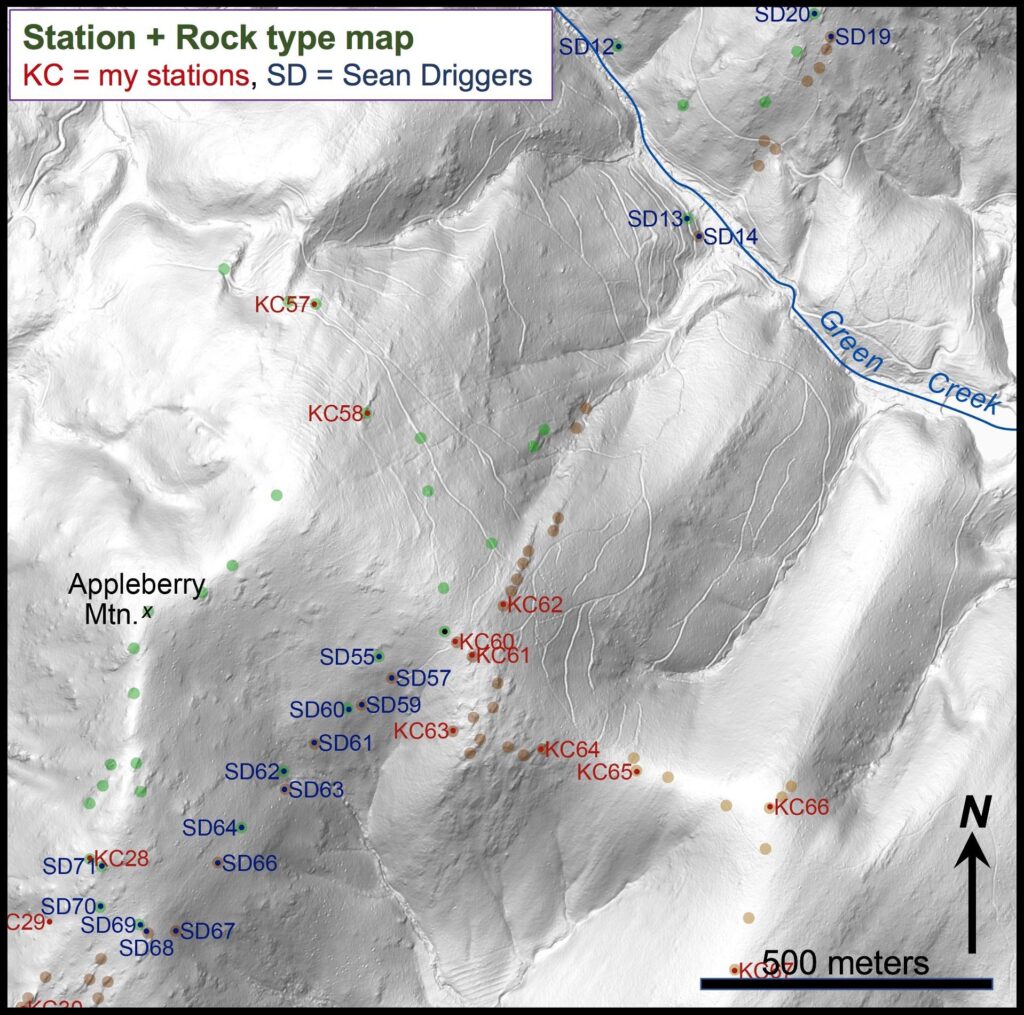
Shaded relief map (from LiDAR topographic data) with stations from my research and Sean Driggers (W&M Geology ’16) across the basement-cover contact near Appleberry Mtn. in the Schuyler 7.5’ quadrangle. Colored dots are different rock types.
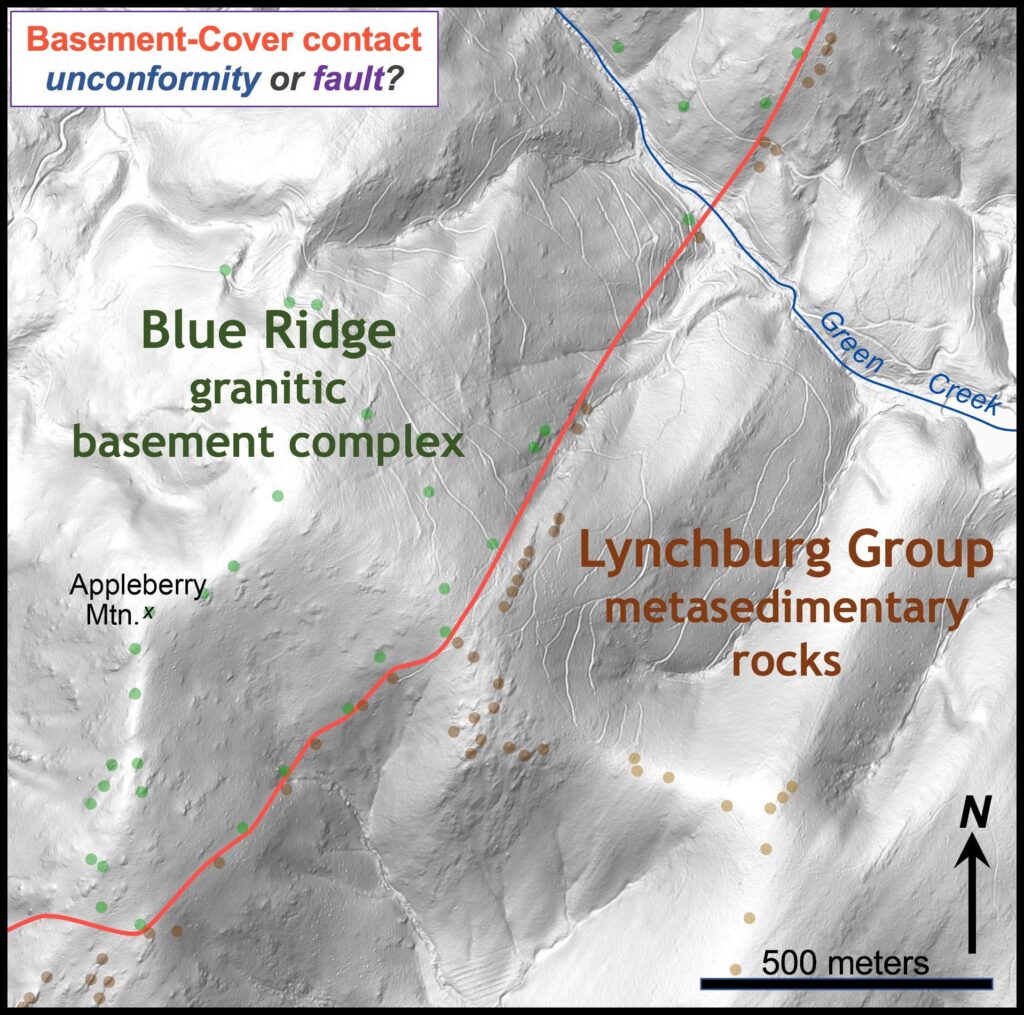
Trace of the contact (orange-red line) between the older granitic basement rocks and the younger metasedimentary rocks of the Lynchburg Group.
2) Pick your record. This is different from picking a song. You pick an album to listen to from start to finish. It’s a musician’s chance to strap you in and take you on a ride — riding their moods of the moment, their moods of the mind, and in the process telling a magnificent story such as Big Pink’s London Calling. In Schuyler, one of my major research themes is to determine whether the basement-cover contact is an unconformity or a fault. This distinction is important because it will give a better idea of the tectonic and depositional history of the region and its relationship to global tectonic events that occurred back in the day. If the contact is an unconformity, we know that there was a period of erosion and much of the geologic record may have been removed. On the other hand, if the contact is a fault, we will be able to decipher the tectonic events that caused such a deformation. But first, we must determine the orientation or attitude of this contact in 3-dimensions.
We do this by using the geological map to generate a structure contour map that illustrates the elevation of the contact across the study area. On the first map below, I’ve labeled the elevation of the basement-cover contact, as determined by where it intersects a particular contour (400, 425, 450 meters etc.).
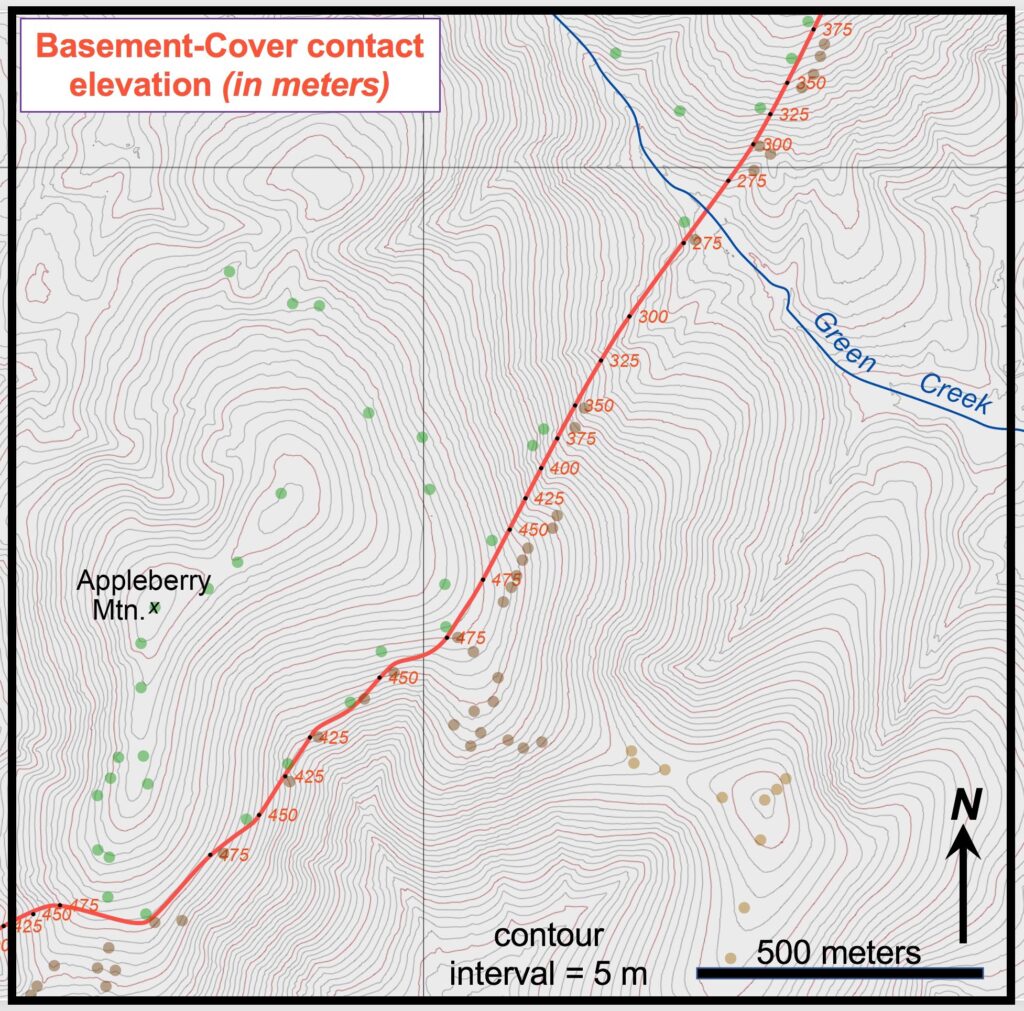
Topographic map (5-meter contour interval) with the basement-cover contact (orange-red line) and elevation labels on the contact. Notice the relatively straight map trace of the contact in the Green Creek valley which indicates that the contact is steeply dipping.
Based on these points, I constructed a series of structure contours that illustrate the elevation of the contact across the map. Notice how the structure contours trend in a northeast-southwest direction. From these contours, I calculated the orientation (strike & dip) of the basement cover-contact at various locations. Interestingly, this contact dips steeply to the northwest which means that the older basement rocks are above the younger metasedimentary rocks!
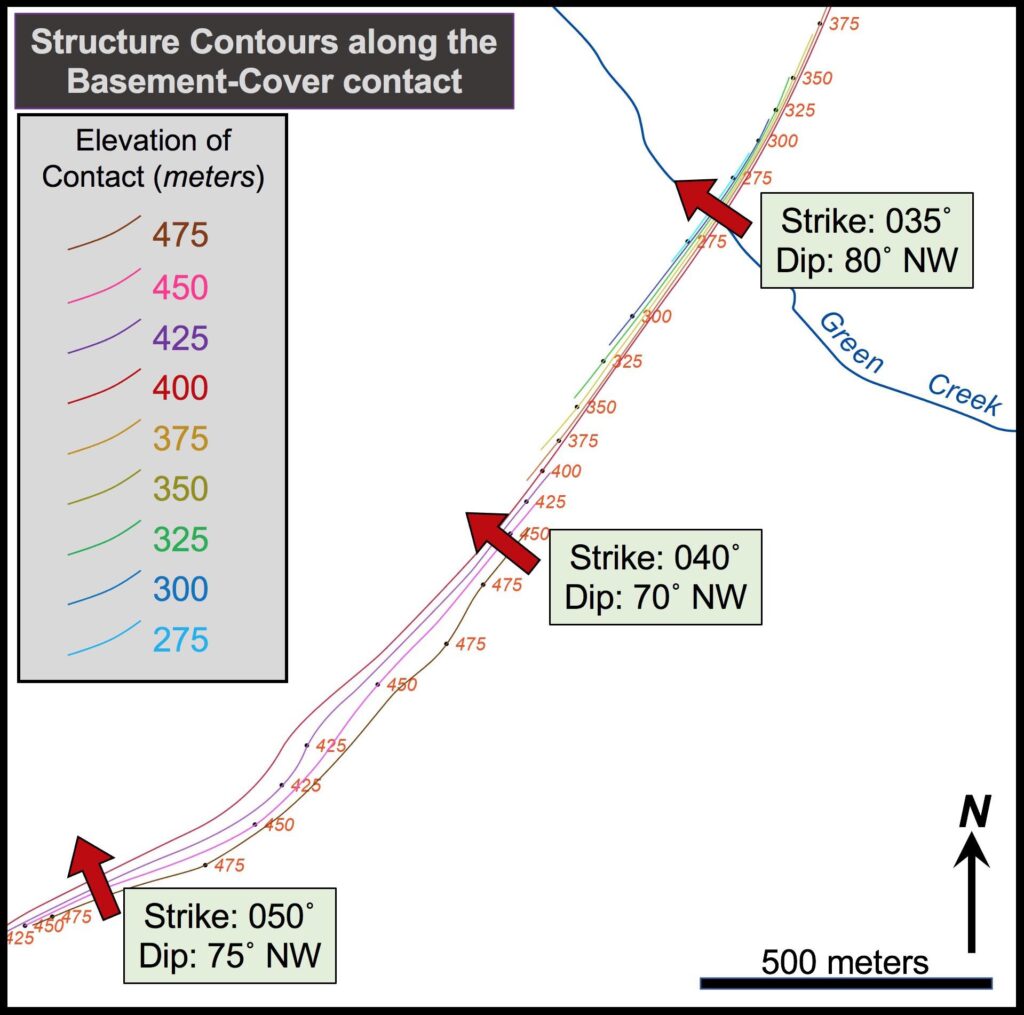
Structure contour map of the basement-cover contact. The orientation of the contact can be quantified based on the structure contours. In this area the basement-cover contact strikes to the northeast (strikes between 035˚ and 050˚) and dips steeply (70 to 80˚) to the northwest.
3) The next step is to spin the record. Carefully take it out of the sleeve, place it on the table, and gently lower the needle. Double check your speed and volume. You want it loud, but not too loud. For this step, in geo time, it was important to take a second look at everything, to analyze some of the samples we had collected. I even spun one of my own rocks- a coarse-grained arkosic meta-sandstone with larger “chunks” or clasts of the granitic basement complex. This is clear evidence that the metasedimentary rocks were sourced from erosion of the older granitic rocks. We interpret this contact to be an unconformity – and a major unconformity at that, one which separates rocks of vastly different age.
4) Listen. Sometimes background music is nice, but what’s even better is to really enjoy the music. As it translates to the Schuyler area, this meant interpreting the data. We took everything that we discovered in the field and built a 3-D model, something a little easier to comprehend than dashes and dots on a map. I created a mystical block diagram which shows an oblique digital view of the landscape with the underlying rock structure. This figure does a great job of highlighting the orientation of the basement-cover contact (dashed red line) with the older basement rocks structurally above the younger rocks. That’s not the original geometry, as the Lynchburg sedimentary rocks were deposited on top of the older basement complex. We interpret this major unconformity to be structurally overturned with all the rocks tilted past vertical. That’s cool, and also a bit crazy. We hope to keep listening to evidence like this, combined with tracks from past geological research to frame out timeline as to how the overall Blue Ridge structure came to be.
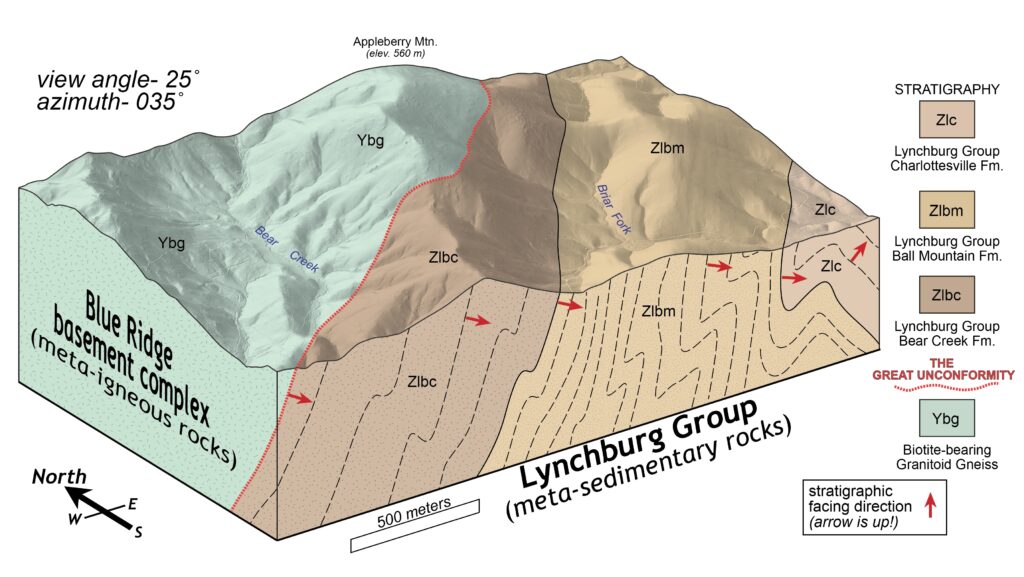
Block diagram of the basement-cover contact. Northwest striking contact dipping steeply to the northwest built from data developed using the structure contours and LiDAR elevation projection.
So, there you have it folks, hopefully this was an interesting look into how I enjoy putting on a nice record, but also a little update into my research adventures.
Comments are currently closed. Comments are closed on all posts older than one year, and for those in our archive.

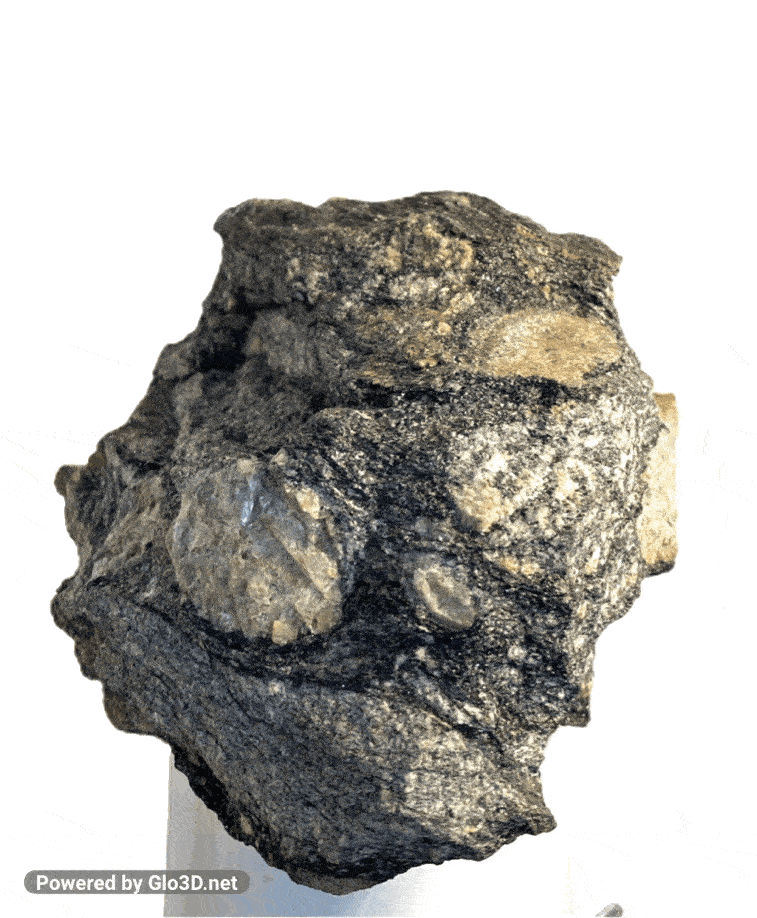

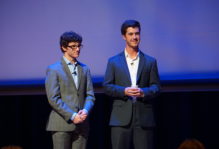
What a great read! I loved the analogy throughout the blog. I don’t know much about geology besides the intro course I took sophomore year, but this blog really broke it down so I could understand.
Absolutely love the music metaphor. Such a great way to take the reader on your ride.
I really enjoyed section 3 analogy about spinning the rock like a record, and looking at the 3D rock spin was like I was studying the rock myself! A great read and enjoyed that you were able to explain geologic terms and processes to those who aren’t geology majors.
This blog Rocks! Literally!
Wow! Such a phenomenal and fresh take on geology. As a computer science major, I can’t say that I usually understand geology, but this post was captivating and explanatory while also detailed and thorough. Can’t wait to read more from Katie in the future!
Loved the connection between music and geology! Who knew rocks could be so interesting? Really great, unique, and fun read!
Loved this blog! Easy to understand and super interesting. Very well written!
Katie- a clever way to present a topic foreign to so many of us. I can’t wait to see your research group’s findings about the Blue Ridge Structure!
Thanks Katie! You made this difficult topic so easy to understand .
What an interesting read, Katie! Your comparison made this topic super relatable and friendly to someone who doesn’t know much about geology. Great work!
This bit made me laugh, “global tectonic events that occurred back in the day”. You know, back in the day…2 billion years ago. LOL. Nice job Katie!
Impressive! Gneiss work…..
Wow! Such great graphics!! They helped me understand such a complex topic.
The clear evidence that the metasedimentary rocks were sourced from erosion of the older granitic rocks is so interesting!
Always enjoy an article that can simplify to my level and hold my interest. Thanks.
Wow! What a creative way of presenting this information. What a gift.
Would usually skip this sort of reading but, like the author, I love albums and the experience of listening to them. Learned some about the rock part of rock and roll along the way. Please give us more content like this. I’m a professor in another field and have a curiosity regarding this subject matter, but I have never had a route like this to such technical information. Well done, Katie ‘22 (aka technical translator extraordinaire).
What an interesting way to connect two things you care about- really enjoyed reading this!
Making geogoloy approachable!
Illuminating in both quality and clarity— a highly rated rock
THANK YOU KATIE CULLEN FOR WRITING THIS AMAZING, EXTRAVAGANT, AWESOME VLOG! – TOTALLY NOT UR COUSIN;)
Such a great blog post, Katie! Great to hear about your fascinating research and all the work you’ve been doing!
This is such a clever way to engage a reader and present geology. Great graphics and such clear explanations!